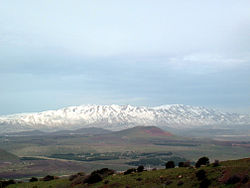This section is a part of a dialogue concerning "seduction and consummation" (until 5:1), where here the man seduces the woman, with extravagant imagery of food and flowers/herbs.
Verse 9
- Thou hast ravished my heart, my sister, my spouse; thou hast ravished my heart with one of thine eyes, with one chain of thy neck. [23]
“Thou hast ravished my heart” (Hebrew: לִבַּבְתִּנִי, Libavtini) is the verb form of the noun for heart, לבב, and literally means "thou has hearted me." This exact form of the word (pi`el perfect) appears only once in the bible, within this verse.
As it comes in the context of a dialogue between two lovers, most translations have given it a meaning of stolen my heart: "You have captivated my heart" (English Standard Version), "Thou hast ravished my heart" (King James Version), "You have made my heart beat faster" (New American Standard Bible), "You have carried my heart away!" (The Complete Jewish Bible), "You have charmed me" (God's Word Translation), "You have thrilled my heart" (New Century's Version), "Thou hast wounded my heart" (Douay-Rheims Catholic Bible), and "Thou hast emboldened me" (Young's Literal Translation). [24]
Traditional Jewish commentators have also given the word "Libavtini" similar interpretations.
- Aramaic Targum: your love is fixed or established upon my heart.
- Rashi: you have drawn my heart to you.
- Ibn Ezra: you have cut off my heart (similar to pruning a branch).
There are two other locations in the bible with the verb form of the root לִ-בַּ-בְ:
- Job 11:12: "Shall an empty man get a mind (Hebrew: יִלָּבֵב) or a wild ass's colt be born a man (?) [25] ." In this verse, the verb form of the word heart takes on a meaning of "get a mind" or "get a heart" - this is because the heart represented in the bible the whole inner world of humans, including both emotions and thoughts. This meaning would be similar to translations of libavtini as "you have rekindled my heart" or "given me a heart".
- 2 Samuel 13:8: "And she took dough, and kneaded it, and made cakes (Hebrew: וַתְּלַבֵּ֣ב) in his sight". [26] In this verse, we see similarities between the ideas of "nourish" in the form of making cakes and the concept of "heartening" someone.
“Thou hast ravished my heart with one of thine eyes.” There could be both literal and figurative interpretations of this sentence. Figuratively, the man expresses how just a fraction of the woman's personality and appearance is sufficient to capture his heart. Literally, this could mean that the woman has only one of her eyes visible. She could be winking, or perhaps, she is looking at the man herself from a hiding spot and only one of her eyes is visible as she peers at him.



